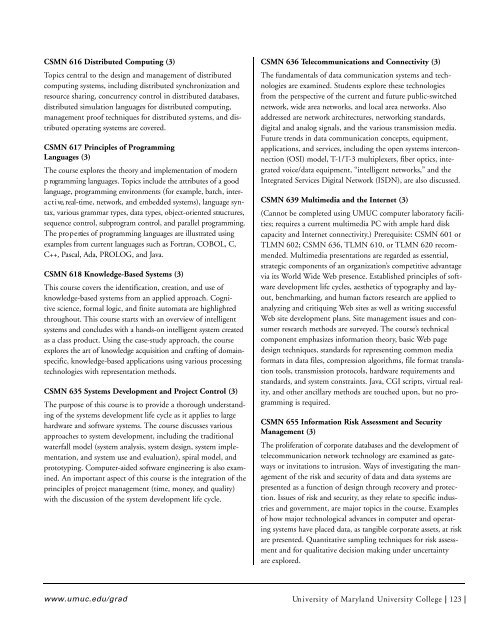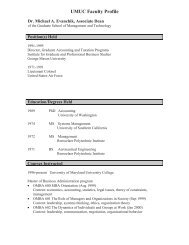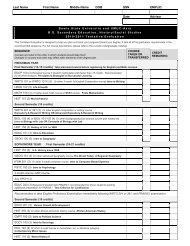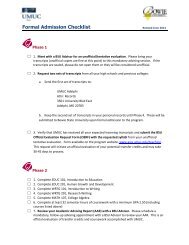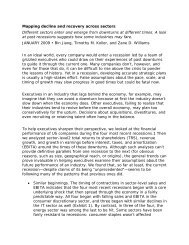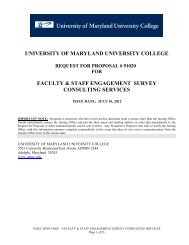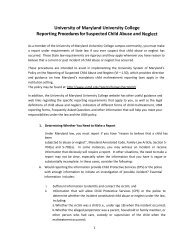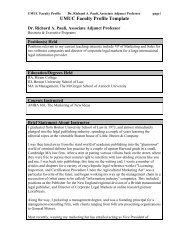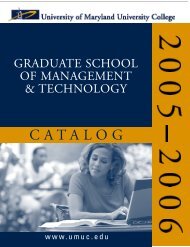A+B. Intro_SJ.1 - University of Maryland University College
A+B. Intro_SJ.1 - University of Maryland University College
A+B. Intro_SJ.1 - University of Maryland University College
Create successful ePaper yourself
Turn your PDF publications into a flip-book with our unique Google optimized e-Paper software.
CSMN 616 Distributed Computing (3)<br />
Topics central to the design and management <strong>of</strong> distributed<br />
computing systems, including distributed synchronization and<br />
resource sharing, concurrency control in distributed databases,<br />
distributed simulation languages for distributed computing,<br />
management pro<strong>of</strong> techniques for distributed systems, and distributed<br />
operating systems are covered.<br />
CSMN 617 Principles <strong>of</strong> Programming<br />
Languages (3)<br />
The course explores the theory and implementation <strong>of</strong> modern<br />
p rogramming languages. Topics include the attributes <strong>of</strong> a good<br />
language, programming environments (for example, batch, intera<br />
c t i ve, real-time, network, and embedded systems), language syntax,<br />
various grammar types, data types, object-oriented stru c t u re s ,<br />
sequence control, subprogram control, and parallel pro g r a m m i n g .<br />
The pro p e rties <strong>of</strong> programming languages are illustrated using<br />
examples from current languages such as Fo rtran, COBOL, C,<br />
C++, Pascal, Ada, PRO LOG, and Ja va.<br />
CSMN 618 Knowledge-Based Systems (3)<br />
This course covers the identification, creation, and use <strong>of</strong><br />
knowledge-based systems from an applied approach. Cognitive<br />
science, formal logic, and finite automata are highlighted<br />
throughout. This course starts with an overview <strong>of</strong> intelligent<br />
systems and concludes with a hands-on intelligent system cre a t e d<br />
as a class product. Using the case-study approach, the course<br />
e x p l o res the art <strong>of</strong> knowledge acquisition and crafting <strong>of</strong> domainspecific,<br />
knowledge-based applications using various processing<br />
technologies with representation methods.<br />
CSMN 635 Systems Development and Project Control (3)<br />
The purpose <strong>of</strong> this course is to provide a thorough understanding<br />
<strong>of</strong> the systems development life cycle as it applies to large<br />
hardware and s<strong>of</strong>tware systems. The course discusses various<br />
approaches to system development, including the traditional<br />
waterfall model (system analysis, system design, system implementation,<br />
and system use and evaluation), spiral model, and<br />
prototyping. Computer-aided s<strong>of</strong>tware engineering is also examined.<br />
An important aspect <strong>of</strong> this course is the integration <strong>of</strong> the<br />
principles <strong>of</strong> project management (time, money, and quality)<br />
with the discussion <strong>of</strong> the system development life cycle.<br />
CSMN 636 Telecommunications and Connectivity (3)<br />
The fundamentals <strong>of</strong> data communication systems and technologies<br />
are examined. Students explore these technologies<br />
from the perspective <strong>of</strong> the current and future public-switched<br />
network, wide area networks, and local area networks. Also<br />
addressed are network architectures, networking standards,<br />
digital and analog signals, and the various transmission media.<br />
Future trends in data communication concepts, equipment,<br />
applications, and services, including the open systems interconnection<br />
(OSI) model, T-1/T-3 multiplexers, fiber optics, integrated<br />
voice/data equipment, “intelligent networks,” and the<br />
Integrated Services Digital Network (ISDN), are also discussed.<br />
CSMN 639 Multimedia and the Internet (3)<br />
(Cannot be completed using UMUC computer laboratory facilities;<br />
requires a current multimedia PC with ample hard disk<br />
capacity and Internet connectivity.) Prerequisite: CSMN 601 or<br />
TLMN 602; CSMN 636, TLMN 610, or TLMN 620 recommended.<br />
Multimedia presentations are regarded as essential,<br />
strategic components <strong>of</strong> an organization’s competitive advantage<br />
via its World Wide Web presence. Established principles <strong>of</strong> s<strong>of</strong>tware<br />
development life cycles, aesthetics <strong>of</strong> typography and layout,<br />
benchmarking, and human factors research are applied to<br />
analyzing and critiquing Web sites as well as writing successful<br />
Web site development plans. Site management issues and consumer<br />
research methods are surveyed. The course’s technical<br />
component emphasizes information theory, basic Web page<br />
design techniques, standards for representing common media<br />
formats in data files, compression algorithms, file format translation<br />
tools, transmission protocols, hardware requirements and<br />
standards, and system constraints. Java, CGI scripts, virtual reality,<br />
and other ancillary methods are touched upon, but no programming<br />
is required.<br />
CSMN 655 Information Risk Assessment and Security<br />
Management (3)<br />
The proliferation <strong>of</strong> corporate databases and the development <strong>of</strong><br />
telecommunication network technology are examined as gateways<br />
or invitations to intrusion. Ways <strong>of</strong> investigating the management<br />
<strong>of</strong> the risk and security <strong>of</strong> data and data systems are<br />
presented as a function <strong>of</strong> design through recovery and protection.<br />
Issues <strong>of</strong> risk and security, as they relate to specific industries<br />
and government, are major topics in the course. Examples<br />
<strong>of</strong> how major technological advances in computer and operating<br />
systems have placed data, as tangible corporate assets, at risk<br />
are presented. Quantitative sampling techniques for risk assessment<br />
and for qualitative decision making under uncertainty<br />
are explored.<br />
w w w. u m u c . e d u / g r a d<br />
Un i versity <strong>of</strong> Ma r yland Un i versity <strong>College</strong> | 123 |


